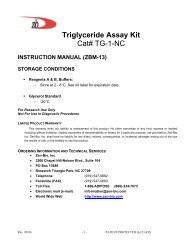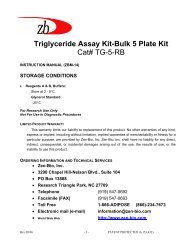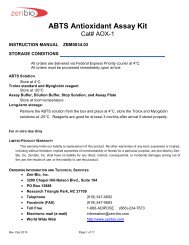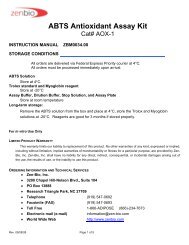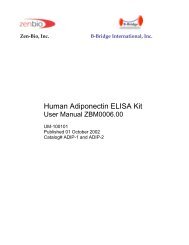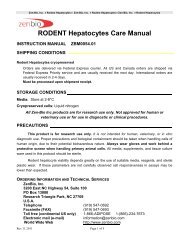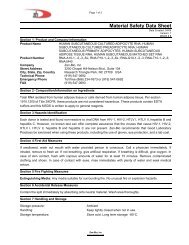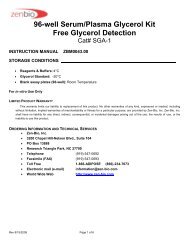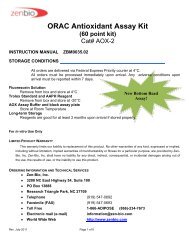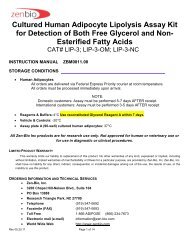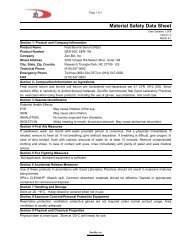Create successful ePaper yourself
Turn your PDF publications into a flip-book with our unique Google optimized e-Paper software.
96-well Serum/Plasma Fatty Acid and Glycerol<br />
Kit for the Detection of Both Non-Esterified<br />
Fatty Acids and Free Glycerol<br />
Cat# <strong>GFA</strong>-1<br />
INSTRUCTION MANUAL<br />
ZBM0033.05<br />
STORAGE CONDITIONS<br />
Reagents & Buffers: 4°C Use reconstituted Glycerol Reagent A within 7 days.<br />
Blank assay plates (96-well): Room Temperature<br />
All <strong>Zen</strong>-<strong>Bio</strong> <strong>Inc</strong> products are for research use only. Not approved for human or veterinary<br />
use or for use in diagnostic or clinical procedures.<br />
LIMITED PRODUCT WARRANTY<br />
This warranty limits our liability to replacement of this product. No other warranties of any kind, expressed or implied, including<br />
without limitation, implied warranties of merchantability or fitness for a particular purpose, are provided by <strong>Zen</strong>-<strong>Bio</strong>, <strong>Inc</strong>. <strong>Zen</strong>-<strong>Bio</strong>, <strong>Inc</strong>.<br />
shall have no liability for any direct, indirect, consequential, or incidental damages arising out of the use, the results of use, or the<br />
inability to use this product.<br />
ORDERING INFORMATION AND TECHNICAL SERVICES<br />
<strong>Zen</strong>-<strong>Bio</strong>, <strong>Inc</strong>.<br />
3200 East NC-54 Suite 100<br />
PO Box 13888<br />
Research Triangle Park, NC 27709<br />
Telephone (919) 547-0692<br />
Facsimile (FAX) (919) 547-0693<br />
Toll Free 1-866-ADIPOSE (866)-234-7673<br />
Electronic mail (e-mail) information@zen-bio.com<br />
World Wide Web http://www.zen-bio.com<br />
Rev 08.14.2013 Page 1 of 10
INTRODUCTION<br />
This kit is designed to accurately determine the amount of free fatty acid and glycerol present in blood<br />
serum or plasma of humans, mice, rats, and other animals in a 96-well format for increased throughput analysis.<br />
Blood can be collected in plain evacuated tubes or in the presence of common anti-coagulants: sodium citrate,<br />
ammonium oxalate and EDTA. NOTE: Heparin or Heparinized tubes should not be used because this will<br />
generate inaccurate readings. Serum should be separated from clotted blood by centrifugation as soon as<br />
possible and may be stored frozen (-20°C) prior to analysis.<br />
PRINCIPLES OF THE ASSAYS<br />
Detection of Non-Esterified Fatty Acids (Free Fatty Acids; FFA)<br />
Assessment of serum fatty acids is through a coupled reaction to measure non-Esterified fatty acids<br />
(NEFA). The initial step, carried out by acyl-CoA synthetase (ACS), produces fatty acyl-CoA thiol esters from the<br />
NEFA, ATP, Mg, and CoA in the reaction.<br />
The acyl-CoA derivatives react with oxygen in<br />
the presence of acyl-CoA oxidase (ACOD) to<br />
produce hydrogen peroxide. Hydrogen<br />
peroxide in the presence of peroxidase (POD)<br />
allows the oxidative condensation of 3-<br />
methyl-N-ethyl-N-(-hydroxyethyl)-aniline with<br />
4-aminoantipyrine which forms a purple<br />
product that absorbs light at 550nm. This<br />
allows the concentration of NEFA to be<br />
determined from the optical density measured<br />
at 540 - 550nm.<br />
HCOOH + ATP + CoA<br />
(NEFA)<br />
Acyl-CoA + O 2<br />
NH 2<br />
N<br />
O<br />
2H N<br />
2 O 2 + +<br />
ACOD<br />
ACS<br />
Acyl-CoA + AMP + PP i<br />
2,3-trans-Enoyl-CoA + H 2<br />
O 2<br />
C 2 H 5<br />
N<br />
N<br />
C 2 H 4 OH<br />
C 2 H 5 POD N<br />
N<br />
O<br />
N<br />
+ 4H 2 O<br />
C 2 H 4 OH<br />
Detection of Free Glycerol<br />
Glycerol present in sample is phosphorylated by adenosine triphosphate (ATP) forming glycerol-1-<br />
phosphate (G-1-P) and adenosine-5’-diphosphate (ADP) in the reaction catalyzed by glycerol kinase. G-1-P is<br />
then oxidized by glycerol phosphate oxidase to dihydroxyacetone phosphate (DAP) and hydrogen peroxide<br />
(H 2 O 2 ). A quinoneimine dye is produced by the peroxidase catalyzed coupling of 4-aminoantipyrine (4-AAP) and<br />
sodium N-ethytl-N-(3-sulfopropyl)m-anisidine (ESPA) with H 2 O 2 , which shows an absorbance maximum at<br />
540nm. The increase in absorbance at 540nm is directly proportional to glycerol concentration of the sample.<br />
GLYCEROL + ATP <br />
G-1-P + ADP<br />
G-1-P + O 2 DAP + H 2 O 2<br />
H 2 O 2 +4-AAP + ESPA <br />
Quinoneimine dye + H 2 O<br />
Rev 08.14.2013 Page 2 of 10
ITEMS INCLUDED IN THE KIT<br />
ITEM DESCRIPTION Cap UNIT QTY STORAGE<br />
Color<br />
Assay Plate, blank 96-well assay plate, blank --- PLATE 3 -----<br />
Dilution Buffer 50 ml --- BOTTLE 1 4°C<br />
FFA Standard 1mM Stock. See page 4 for standard AMBER 100 l / 1 4°C<br />
curve preparation<br />
VIAL<br />
FFA Diluent A YELLOW 10.5 ML 1 4°C<br />
FFA Diluent B PINK 5.5 ML 1 4°C<br />
FFA Reagent A Reconstitute using 10.5 ml FFA Diluent YELLOW BOTTLE 1 4°C<br />
A. Discard remainder after 10days<br />
FFA Reagent B Reconstitute using 5.5 ml FFA Diluent PINK BOTTLE 1 4°C<br />
B. Discard remainder after 10 days<br />
Glycerol Reagent Reconstitute with 11.0 ml deionized --- BOTTLE 1 4°C<br />
A (cat# RGTA-10)<br />
Tray<br />
Glycerol standard<br />
(cat# LIP-GLYSTAN)<br />
water prior to use. Use within 7 days.<br />
For multi-channel pipetters, clear<br />
polyvinyl<br />
Glycerol @ 1mM [Dilute with 400 l<br />
Dilution Buffer to make the 200 M<br />
glycerol standard; see page 5 for<br />
recommended dilution scheme]<br />
CLEAR EACH 2 -----<br />
ORANGE 100 l /<br />
Other equipment/reagents required but not provided with the kit:<br />
Multi-channel Pipet , single channel pipet and pipet tips<br />
Plate reader with a filter of 540 nm<br />
<strong>Inc</strong>ubator at 37 o C<br />
Large gauge needle<br />
Tubes for diluting standards<br />
VIAL<br />
1 -20°C<br />
Rev 08.14.2013 Page 3 of 10
ASSAY PROCEDURE<br />
A. DETECTION OF NON-ESTERIFIED FATTY ACIDS<br />
1. Prepare the NEFA standard curve using the FFA STANDARD SOLUTION as follows:<br />
Briefly spin down the contents of the free fatty acid standard tube. Standards are: 0, 1.4, 4.1, 12.3,<br />
37, 111, and 333 M fatty acid. Prepare as follows:<br />
The kit standard solution is the 1.0 mM standard. Pipette 120 l of Dilution Buffer into 6 tubes (not<br />
provided). Pipette 60 l of the FFA Standard Stock into a tube labeled 333 µM. Prepare a dilution<br />
series as depicted below. Mix each new dilution thoroughly before proceeding to the next. The<br />
Dilution Buffer alone serves as the zero standard.<br />
60 l 60 l 60 l 60 l 60 l 60 l<br />
Std<br />
FFA<br />
Std<br />
333<br />
M<br />
111<br />
M<br />
37<br />
M<br />
12.3<br />
M<br />
4.1<br />
M<br />
1.4<br />
M<br />
Note: The above dilution series generates enough volume to perform the standard curve in duplicate.<br />
If you wish to perform the standard curve in duplicate, please note that seven fewer data points can<br />
be assayed with this kit.<br />
2. Also at this time prepare the FFA Reagent A by adding 10.5 ml FFA Diluent A per bottle and gently<br />
inverting. DO NOT VORTEX! Store any remaining solution at 2-8C; it is stable for 10 days after<br />
reconstitution refrigerated (2-8C).<br />
3. Add 5 l (or 1 - 10 l) of serum or plasma to a well of Plate A. Add dilution buffer to each well to total 50 l<br />
including serum or plasma sample. THIS RESULTS IN A 10x DILUTION OF YOUR SAMPLE (5 l in 50<br />
l). Add 50 l of each standard to empty wells (use PLATE B if necessary).<br />
4. Add the reconstituted FFA Reagent A to one of the disposable trays provided in the kit. Add 100 l of FFA<br />
Reagent A to each well. Gently shake the plate to ensure mixing. Place in a 37 o C incubator for 10<br />
minutes.<br />
5. Prepare the FFA Reagent B by adding 5.5 ml FFA Diluent B per bottle and gently inverting. DO NOT<br />
VORTEX! Store any remaining solution at 2-8C; it is stable for 10 days after reconstitution refrigerated<br />
(2-8C).<br />
6. Add the reconstituted FFA Reagent B to the other disposable tray provided in the kit. Add 50 l of FFA<br />
Reagent B to each well. Gently shake the plate to ensure mixing. Place in a 37 o C incubator for 10<br />
minutes.<br />
Rev 08.14.2013 Page 4 of 10
7. Allow the plate to equilibrate to room temperature for 5 minutes. During this time, ensure that there are no<br />
bubbles in the solution mixture. Use a large gauge needle or clean pipet tip to pop any bubbles as this will<br />
result in inaccurate absorbance readings.<br />
8. The optical density of each well is then measured at 540 nm.<br />
B. DETECTION OF FREE GLYCEROL<br />
1. Prepare the glycerol standards as follows:<br />
Briefly spin down the contents of the glycerol standard tube before reconstitution. Pipette 400 l of<br />
Dilution Buffer into the 1 mM glycerol standard tube provided and mix well by vortexing. This<br />
produces a diluted stock glycerol standard of 200 M. Pipette 250 l of dilution buffer into 6 tubes<br />
(not provided). Using the newly diluted stock glycerol solution, prepare a dilution series as<br />
depicted below. Mix each new dilution thoroughly before proceeding to the next. The 200 M<br />
stock dilution serves as the highest standard, and the dilution buffer serves as the zero standard.<br />
400 l 250 l 250 l 250 l 250 l 250 l 250 l<br />
Dilution<br />
Buffer<br />
Std<br />
200<br />
M<br />
100<br />
M<br />
50<br />
M<br />
25<br />
M<br />
12.5<br />
M<br />
6.25<br />
M<br />
3.125<br />
M<br />
Note: The above dilution series generates enough volume to perform the standard curve in<br />
duplicate. If you wish to perform the standard curve in duplicate, please note that eight fewer data<br />
points can be assayed with this kit.<br />
2. Also at this time prepare the Glycerol Reagent A by adding 11.0 ml room temperature deionized water per<br />
bottle and gently invert. DO NOT VORTEX! Use a pipet to ensure that the powder is completely<br />
dissolved. Store at room temperature. If using a Reagent A solution previously prepared and stored at 2-<br />
8C, also bring to room temperature. Make sure there is enough Reagent A from one solution to treat all<br />
the points in the assay. It may be necessary to combine solutions. Store in a light protected bottle.<br />
Reconstituted Glycerol Reagent A is stable for 7 days refrigerated (2-8C); store any remaining solution<br />
refrigerated (2-8C).<br />
3. Add 20 l (or 10 - 25 l) of serum or plasma to a well of a blank plate for assessment of free glycerol. Add<br />
30l of dilution buffer to each well to total 50 l including serum or plasma sample. THIS RESULTS IN A<br />
2.5x DILUTION OF YOUR SAMPLE (20 l in 50 l). Add 50 l of each standard to empty wells (use<br />
another plate, if necessary).<br />
4. Add the reconstituted Glycerol Reagent A solution to one of the disposable trays provided in the kit. Add<br />
50 l of Reagent A to each well of the glycerol plate. Gently, pipet up and down once to mix. Pop the<br />
Rev 08.14.2013 Page 5 of 10
ubbles using a large gauge needle or a clean pipet tip. The plate is then incubated at 25 o C (room<br />
temperature) for 15 minutes.<br />
5. The optical density of each well is then measured at 540 nm.<br />
FATTY ACID STANDARD CURVE<br />
Generate standard curve: see example below<br />
[DO NOT use this standard curve to generate your data. This is an example.]<br />
Subtract the OD value of the 0M standard from all OD values including the standard curve. . Note:<br />
1mM standard is commonly omitted from analysis due to lack of linearity between 333 M and 1mM.<br />
Optionally, a 4-parameter fit may be used to calculate standard curve.<br />
uM FFA OD OD<br />
ODblank<br />
ODblank<br />
Avg<br />
ODblank<br />
0 0.05 0.048 0.049<br />
1.4 0.051 0.053 0.002 0.004 0.003<br />
4.1 0.056 0.058 0.007 0.009 0.008<br />
12.3 0.070 0.075 0.021 0.026 0.024<br />
37 0.119 0.122 0.070 0.073 0.072<br />
111 0.274 0.277 0.225 0.228 0.227<br />
333 0.689 0.750 0.640 0.701 0.671<br />
Slope 0.002<br />
Intercept -0.001<br />
R 2 1.000<br />
y = observed O.D. minus the blank<br />
x = concentration of FFA in M<br />
To calculate x for each y, (i.e. to change the observed O.D. into FFA concentration) use the following<br />
equation:<br />
y=(slope) times (x) plus intercept<br />
y=mx+b so x=(y-b)/m<br />
x=(y – (-0.001))/0.002 where 0.002= slope of the line and -0.001= y intercept. Be careful to enter the<br />
proper sign for the y intercept value as it may be a negative number.<br />
Data are expressed as M free fatty acids released.<br />
OPTION: express data as Fold induction over appropriate vehicle<br />
Fold induction = M free fatty acids SAMPLE<br />
M free fatty acids VEHICLE<br />
The R 2 value should be equal or greater then 0.98 for the standard curve to be valid. Any R 2 values<br />
below 0.98 must have the standard curve run again.<br />
Rev 08.14.2013 Page 6 of 10
GLYCEROL STANDARD CURVE<br />
Generate standard curve: see example below<br />
[DO NOT use this standard curve to generate your data. This is an example.]<br />
Subtract the OD value of the 0M standard from all OD values including the standard curve.<br />
uM<br />
glycerol OD OD<br />
ODblank<br />
ODblank<br />
Avg<br />
ODblank<br />
0 0.044 0.041 0.043<br />
3.125 0.054 0.053 0.012 0.011 0.011<br />
6.25 0.062 0.063 0.020 0.021 0.020<br />
12.5 0.083 0.084 0.041 0.042 0.041<br />
25 0.126 0.125 0.084 0.083 0.083<br />
50 0.205 0.208 0.163 0.166 0.164<br />
100 0.372 0.374 0.330 0.332 0.331<br />
200 0.698 0.697 0.656 0.655 0.655<br />
Slope 0.003<br />
Intercept 0.001<br />
R 2 1.000<br />
y = observed O.D. minus the blank<br />
x = concentration of glycerol in M<br />
To calculate x for each y, (i.e. to change the observed O.D. into glycerol concentration) use the following<br />
equation:<br />
y=(slope) times (x) plus intercept<br />
y=mx+b so x=(y-b)/m<br />
x=(y – (0.001))/0.003 where 0.003= slope of the line and 0.001= y intercept. Be careful to enter the<br />
proper sign for the y intercept value as it may be a negative number.<br />
Any OD values greater than the highest standard (200 M) should be suspect. The compound should be<br />
re-assayed using a lower dose of the compound at treatment OR a dilute solution of the condition<br />
medium at the time of the assay.<br />
The R 2 value should be equal or greater than 0.98 for the standard curve to be valid. Any R 2<br />
values below 0.98, must have the standard curve run again.<br />
Data are expressed as M glycerol.<br />
REMEMBER TO ACCOUNT FOR THE DILUTION FACTOR IN STEP 3.<br />
Rev 08.14.2013 Page 7 of 10
FREQUENTLY ASKED QUESTIONS:<br />
1. Can I buy the reagents separately The Glycerol Standard, cat# LIP-GLYSTAN, Free fatty<br />
Acid Standard, cat# FFA-STAN and Glycerol Reagent A, cat# RGTA-10 are sold separately. LIP-<br />
2/3 Assay Buffer, Free Fatty Acid Reagents and Diluents A and B are not sold separately.<br />
2. I need to know the concentration of the BSA in the Assay Buffer <strong>Zen</strong><strong>Bio</strong>, <strong>Inc</strong> does not<br />
provide the concentrations of the components of our media and buffers. If knowledge of the BSA<br />
concentration is critical to your experiment, you may order Assay Buffer WITHOUT BSA for no<br />
additional charge. Please note it on your order.<br />
3. What is the Free Fatty Acid standard Free Fatty Acid standard (cat# FFA-STAN) is oleic acid<br />
in an aqueous buffer.<br />
4. I have more samples plus standards to run than can fit on 1 96 well plate. Can I compare<br />
data obtained from multiple plates The lipolysis kit is designed for the assay of a single plate.<br />
You may purchase 2 kits of the same lot number. You may then use one plate that includes the<br />
blank, vehicle(s), and positive and negative controls. The second plate may then be used for the<br />
remainder of your samples assayed. In order to obtain comparable data, both plates must be<br />
assayed on the same day using kits and cells from the same lot number. An additional blank<br />
assay plate is provided for the assay of glycerol standards.<br />
Rev 08.14.2013 Page 8 of 10
A<br />
B<br />
C<br />
D<br />
E<br />
F<br />
G<br />
H<br />
1 2 3 4 5 6 7 8 9 10 11 12<br />
APPENDIX A: PLATE LAYOUT<br />
Rev 08.14.2013 Page 9 of 10
APPENDIX B: PROCEDURE FLOWCHART<br />
NEFA Detection<br />
Add 5 l/well test sample and 45 l/well dilution buffer<br />
to one of the blank assay plates provided.<br />
Add 50 l/well diluted standard curve to empty wells.<br />
Sample<br />
5 l<br />
Plate A<br />
OOOOOOOOOOOO<br />
OOOOOOOOOOOO<br />
OOOOOOOOOOOO<br />
OOOOOOOOOOOO<br />
OOOOOOOOOOOO<br />
Plate B<br />
Reconstitute FFA Reagent A using Diluent A.<br />
Add 100l/well. <strong>Inc</strong>ubate 10 minutes @ 37C.<br />
Reconstitute FFA Reagent B using Diluent B.<br />
Add 50l/well. <strong>Inc</strong>ubate 10 minutes @ 37C.<br />
OOOOOOOOOOOO<br />
OOOOOOOOOOOO<br />
OOOOOOOOOOOO<br />
OOOOOOOOOOOO<br />
OOOOOOOOOOOO<br />
OOOOOOOOOOOO<br />
OOOOOOOOOOOO<br />
OOOOOOOOOOOO<br />
OOOOOOOOOOOO<br />
OOOOOOOOOOOO<br />
100l/well<br />
FFA Reagent A<br />
50l/well<br />
FFA Reagent B<br />
OOO<br />
OOO<br />
OOO<br />
OOO<br />
OOO<br />
OOO<br />
OOO<br />
OOO<br />
OOO<br />
OOO<br />
An additional<br />
plate may be<br />
necessary for<br />
the assay of<br />
standards.<br />
Place at room temp. for 5 minutes. Pop any<br />
bubbles in each well using a clean pipet tip or large<br />
gauge needle.<br />
Measure the optical density of each well<br />
at 540 nm using a spectrophotometer<br />
plate reader.<br />
Reminder: Sample was diluted in Step 3<br />
Glycerol Detection<br />
Add 20 l/well test sample and 30 l/well dilution<br />
buffer to one of the blank assay plates provided.<br />
Add 50 l/well diluted standard curve to empty wells.<br />
Sample<br />
20 l<br />
Plate A<br />
OOOOOOOOOOOO<br />
OOOOOOOOOOOO<br />
OOOOOOOOOOOO<br />
OOOOOOOOOOOO<br />
OOOOOOOOOOOO<br />
Reconstitute Glycerol Reagent A.<br />
Add 50l/well.<br />
OOOOOOOOOOOO<br />
OOOOOOOOOOOO<br />
OOOOOOOOOOOO<br />
OOOOOOOOOOOO<br />
OOOOOOOOOOOO<br />
50l/well<br />
Glycerol<br />
Reagent A<br />
OOO<br />
OOO<br />
OOO<br />
OOO<br />
OOO<br />
Plate B<br />
<strong>Inc</strong>ubate 15 minutes @ room temperature.<br />
Measure the optical density of each well<br />
at 540 nm using a spectrophotometer<br />
plate reader.<br />
Reminder: Sample was diluted in Step 3<br />
Rev 08.14.2013 Page 10 of 10



